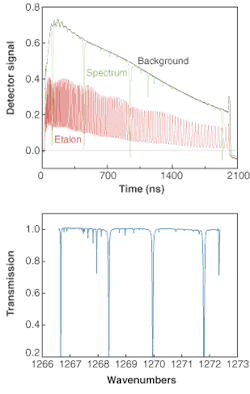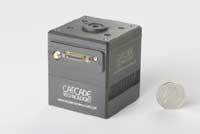Quantum-cascade lasers smell success
Since they were first demonstrated at Bell Laboratories in 1994, quantum-cascade (QC) lasers have been gaining acceptance as the mid-infrared source of choice. Their shift out of the laboratory into real-world applications has been accelerated by the lure of steep performance improvements across a diverse array of applications, including range finding, electronic countermeasures, free-space optical telecommunications, and chemical sniffing. Chemical sniffing, in particular, offers potential markets in environmental monitoring, health, and safety, security, defense, and medical diagnostics. Quantum-cascade lasers, along with recent developments in gas sensors, are expected to yield superior levels of spectroscopic performance in terms of detection and selectivity, consequently opening huge chemical-sniffing markets.
Conventional semiconductor lasers, such as the lead-salt devices commonly used in the mid-IR, rely on electron-hole recombination across the doped semiconductor bandgap to emit photons. The QC laser, which is about the size of a pinhead, operates on a fundamentally different principle: electrons cascade down a series of quantum wells, which result from the growth of very thin layers of semiconductor material. Whereas a single electron-hole recombination can only produce a single photon, the quantum-cascade laser electron can cascade down between 20 and 100 quantum wells producing a photon at each step. This electronic waterfall significantly boosts lasing efficiency, enabling QC lasers to emit several watts of peak power in pulsed operation and tens of milliwatts in continuous wave.
The lasing wavelength for QC lasers is determined not by the choice of semiconductor material, as with conventional lasers, but by adjusting the physical thickness of the semiconductor layers. This technology removes the material barriers commonly associated with conventional semiconductor laser technology and opens up the possibility of near-IR to terahertz spectral coverage. For the first time, an IR spectroscopic laser source has become available that has high output powers, large spectral coverage, excellent spectral quality, and good tunability-with no need for cryogenic cooling.
Inter- and intrapulse spectroscopy
The practical implementation of QC lasers in spectroscopy started in earnest in the late 1990s with researchers eager to harness the power of a source spanning the full spectrum of the technologically significant mid-IR wavelengths (3 to 25 µm). Two methods of direct absorption spectroscopy have resulted from this research. Known as inter- and intrapulse spectroscopy, both methods maximize the performance of the QC laser as a spectroscopic tool.Interpulse spectroscopy uses the QC laser in pulsed mode at or close to room temperature.1 Optical transmission is produced by combining ultrashort-current pulses to the laser with a slowly varying current or temperature ramp, superimposed to tune the laser wavelength through the spectroscopic transition of interest. However, pulsing the laser in this way results in a frequency chirp, broadening the laser linewidth and reducing spectral resolution. So the pulse width must be limited to less than a few tens of nanoseconds while keeping the pulse amplitude close to the lasing threshold. The typical tuning range for this technique is on the order of 1 or 2 cm-1 with repetition rates ranging from tens of hertz to kilohertz.
Unfortunately, threshold-current limitation, introduction of noise due to ultrashort pulse-to-pulse variability, and lower duty cycles have prevented interpulse spectroscopy from achieving the highest level of sensitivity currently available using other spectroscopic techniques.
Intrapulse spectroscopy, like interpulse, uses the laser in pulsed mode to enable room-temperature operation.2 Rather than trying to minimize the frequency chirp brought about by pulsing the QC laser, however, the chirp is harnessed to provide a nearly instantaneous frequency sweep through the spectroscopic features of interest. Pulse widths up to several microseconds are used with pulse amplitudes several amps above lasing threshold to produce a top-hat-current pulse that causes localized heating within the laser and consequently a frequency downchirp, which is typically between 4 and 6 cm-1 wide. The spectral resolution in this case is defined by the instantaneous linewidth of the laser as it sweeps in wavelength and is given by:
where dν/dt is the chirp rate and k is a form factor defined by the pulse shape.3 Typical QC-laser frequency downchirps will normally have better than 0.01-cm-1 spectral resolution, which is better than the interpulse technique for the same chirp rate. Repetition rates of up to 100 kHz can be used, giving high duty cycles and the resulting spectra can be averaged to provide excellent signal-to-noise levels.
This quasi-CW intrapulse regime provides another less obvious but significant spectroscopic advantage: the fast chirp rate can be used in conjunction with careful optical design to ensure incoherent optical feedback.4 This is used to prevent laser feedback noise and optical fringing-the common noise floors for most practical implementations of optical spectrometer design. The removal of this noise floor, without the need for complex fringe removal techniques such as Brewster Plate spoilers or expensive optical isolators, enables this technology to be easily transferred to real-world applications.Applications
The wide spectral tunability that results from using a QC laser and new techniques such as intrapulse spectroscopy is typically an order of magnitude greater than laser-based systems, offering the potential for observing anywhere between five and ten gases with a single laser. This ability will open access to volume markets in the health and safety field and in environmental monitoring, which have been previously inaccessible to laser absorption spectroscopy because of the cost and complexity associated with multiple-laser systems. Large dynamic range, excellent sensitivity, and failsafe operation combined with the solid-state reliability should easily overcome many of the technological hurdles that impede existing technology in these markets. When used in multiple-laser systems, intrapulse QC laser spectroscopy offers broadband spectral coverage that can potentially be used to identify and quantify complex heavy molecules such as those found in toxic chemicals, explosives, and drugs. This will open up lucrative markets in defense and security.A major step toward achieving significant penetration in these markets will come from recent developments in spectrometer hardware. New QC-laser systems, capable of operating in both inter- and intrapulse mode, with miniaturized integrated electronic systems, plug-and-play interfaces, and integrated micro-optics, will banish the unwieldy, fragile, and expensive instrumentation of the past. The resulting ruggedized sensors, tailored for high performance and use in harsh environments, will eradicate common optical instrumentation failings such as mechanical misalignment and drift. Integrated pulse circuitry to minimize mismatch and enhance rise/fall-time performance ensures excellent laser stability, while a USB plug-and-play interface can give instant access to all spectrometer control and engineering data.
REFERENCES
1. K. Namjou et al., Opt. Lett. 23, 219 (February 1998).
2. E. L. Normand, et al., Opt. Lett. 28,16 (January 2003).
3. M. T. McCulloch, E. L. Normand et al., J. OSA B 20(8) 1761 (August 2003).
4. E. L. Normand et al., International Patent PCT/GB2003/001510.
New uses for spectroscopy
In this applications-oriented Optoelectronics World (OEW) supplement on spectroscopy, Iain Howieson, Erwan Normand, and Michael T. McCulloch of Cascade Technologies (Glasgow, Scotland) provide an excellent discussion of advances in techniques and hardware that are making “chemical sniffing” less costly and more effective.
Next, Andrew Dawson of Gage Applied Technologies (Lachine, Quebec, Canada) describes the role of digitizers in enabling high data-transfer rates that in turn enable modern spectroscopy systems to follow the high signal-repetition rates encountered in many modern applications.
Marco Arrigoni of Coherent (Santa Clara, CA) concludes this OEW by showing how emerging computer-controlled ultrafast-laser systems are enabling biological and material scientists to cover a wide range of spectroscopy applications with a highly flexible single system, while performing groundbreaking research.—Hassaun A. Jones-Bey
About the Author
Iain Howieson
Director of R&D, Cascade Technologies
Iain Howieson is director of R&D at Cascade Technologies (Glasgow, Scotland).
Erwan Normand
Technical Director, Cascade Technologies
Erwan Normand is technical director at Cascade Technologies (Glasgow, Scotland).
Michael McCulloch
Laser Spectroscopist, Cascade Technologies
Michael McCulloch is a laser spectroscopist at Cascade Technologies (Glasgow, Scotland).




